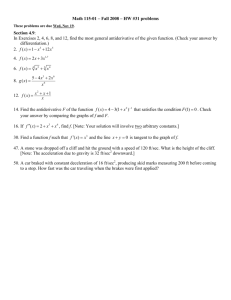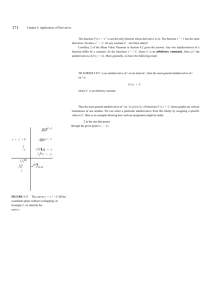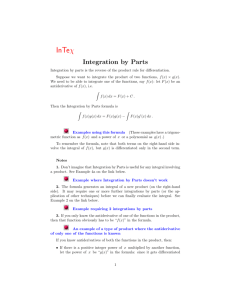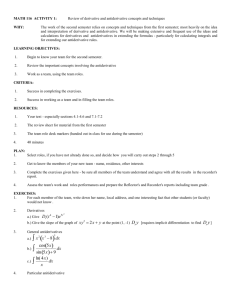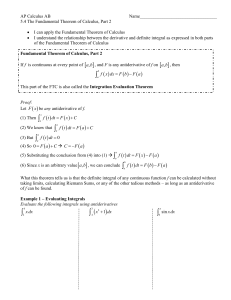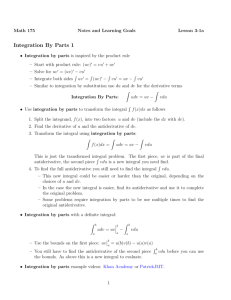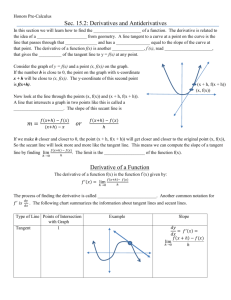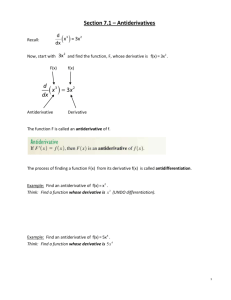doc version
advertisement
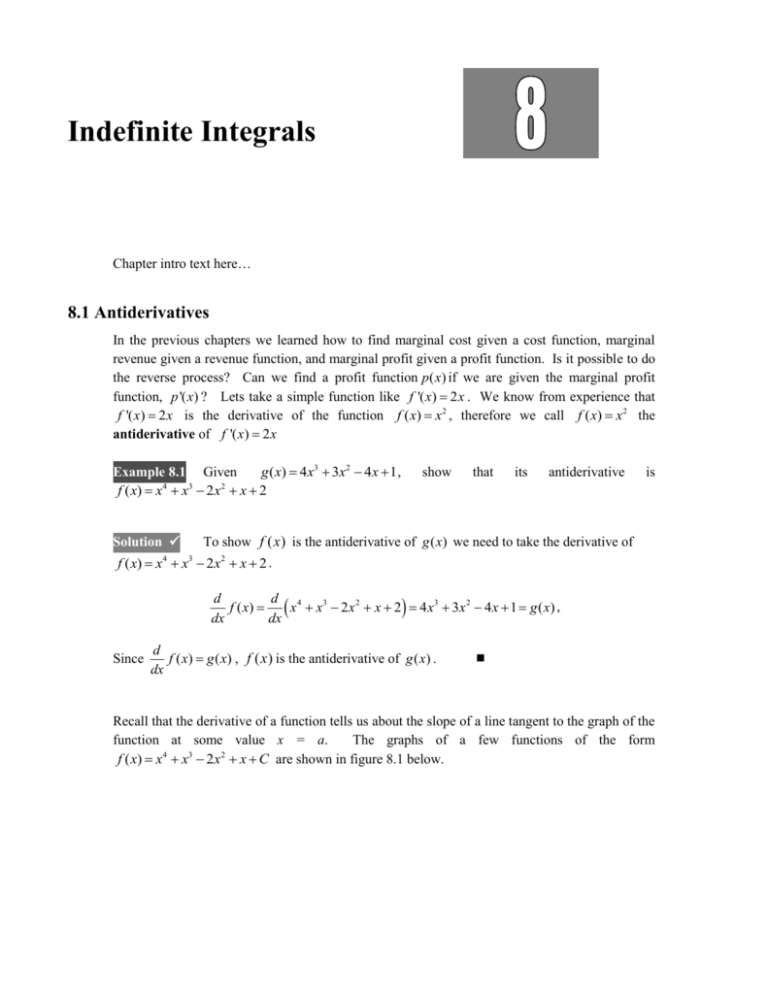
Indefinite Integrals Chapter intro text here… 8.1 Antiderivatives In the previous chapters we learned how to find marginal cost given a cost function, marginal revenue given a revenue function, and marginal profit given a profit function. Is it possible to do the reverse process? Can we find a profit function p( x) if we are given the marginal profit function, p '( x) ? Lets take a simple function like f '( x) 2 x . We know from experience that f '( x) 2 x is the derivative of the function f ( x) x2 , therefore we call f ( x) x2 the antiderivative of f '( x) 2 x Example 8.1 Given g ( x) 4x3 3x2 4x 1, f ( x) x4 x3 2x2 x 2 Solution show that its antiderivative is To show f ( x ) is the antiderivative of g ( x) we need to take the derivative of f ( x) x x 2x2 x 2 . 4 3 d d f ( x) x 4 x 3 2 x 2 x 2 4 x 3 3x 2 4 x 1 g ( x ) , dx dx Since d f ( x) g ( x) , f ( x ) is the antiderivative of g ( x) . dx Recall that the derivative of a function tells us about the slope of a line tangent to the graph of the function at some value x = a. The graphs of a few functions of the form 4 3 2 f ( x) x x 2x x C are shown in figure 8.1 below. Figure 8.1 Graphs of f ( x) x4 x3 2x2 x 1 and g ( x) x4 x3 2x2 x 3 Note to authors: This is saved as chpt8_fig1.eps also. Since the shape of each curve is the same and the curves are just translations of one another, we would predict that the slope of the tangent lines at all values of x = a must be the same for f ( x ) and g ( x ) . Figure 8.2 below has the tangent line drawn for both curves at x = –1. Figure 8.2 Graphs of 4 3 2 g ( x) x x 2x x 3 at x = –1. tangent lines to f ( x) x4 x3 2x2 x 1 and Since the two tangent lines at x = –1 are parallel, f '(1) g '(1) . Thus, it seems safe to conclude that f '(a) g '(a) for all values of x = a. We can also show this algebraically and see that f '( x) 4x3 3x2 4x 1 and g '( x) 4x3 3x2 4x 1 . So, which function, f ( x ) or g ( x ) is the antiderivative of 4 x3 3x 2 4 x 1 ? The answer is that both f ( x ) and g ( x ) are antiderivatives of 4 x3 3x 2 4 x 1 . As a matter of fact, any function of the form f ( x) x4 x3 2x2 x C , where C is some constant, is an antiderivative of Thus, the most general antiderivative of h( x) 4 x3 3x2 4 x 1 4 x3 3x 2 4 x 1 . is H ( x) x4 x3 2 x2 x C . To actually find an antiderivative we need to use the following rule. Power Rule for Antiderivatives If n 1 then the most general antiderivative of x n is 1 n1 x C , where C is an arbitrary constant. n 1 Example 8.2 Find the most general antiderivative of f '( x) x2 . Solution Using the power rule for antiderivatives we obtain f ( x) 1 21 1 3 x x C . 2 1 3 This process of antidifferentiation is also know as integration. Integration uses the symbol (called the integral sign) to denote that the antiderivative of a function is to be taken. When the integral sign is used we always find the most general antiderivative of the function that immediately follows the integral sign. The arbitrary constant C that comes from finding the most general antiderivative is called the constant of integration. x 3 Example 8.3 Find Solution We need to find the most general antiderivative of x using the power rule. 2 dx 3 2 x 3 2 1 3 x ( 2 1) C ( 2 1) 1 3 2 x( 2 2 ) C 3 2 ( 2 2) 1 5 x 2 C dx 3 5 2 2 5 x 2 C 5 Notice that the integral sign and the dx are no longer written after the power rule is applied. This is because the operation of integration has been performed. You can think of this in the same manner you do the plus sign when you figure 2 + 2 = 4. What happened to the plus sign on the right side of the equation? It was no longer written because you performed the operation of addition. The following rules will help us find antiderivatives of more complicated functions. Let k and C be constants, then 1) k dx kx C Example 8.4 2) k f ( x) dx k f (x) dx 3) [ f ( x) g ( x)] dx f ( x) dx g ( x) dx Find the indefinite integral. a) 1 2x 2 b) 2 dx 3 3x 3 5 2 x 7 dx Solution a) Using the rules from above and the power rule we get 2x 5 7 dx 2 x 5 dx 7 dx 2 x5 dx 7 dx 1 51 2 x 7x C 5 1 1 x6 7 x C 3 Differentiating the answer will demonstrate that the answer checks. b) 1 2x 2 1 2x 2 dx dx 3x 2 3 3x 2 3 dx 1 2 3 x 2 dx x 2 dx 3 3 1 1 3 2 1 x 21 x ( 2 1) C 3 2 1 3 3 2 1 1 2 2 5 x 1 x 2 C 3 3 5 3 3 5 1 4x 2 C 3x 15 The last two antiderivatives we need to investigate at are those that involve the natural logarithm and the exponential function with base e. Recall that d 1 d x ln x and e ex . dx x dx This leads us to the following rules. 1) 2) e x dx e x C 1 1 x dx x dx ln | x | C Example 8.5 Find the indefinite integral. 3 x 2e x 5 dx Solution 3 x 2e x 1 5 dx 3 dx 2 e x dx 5 dx x 3ln | x | 2 e x 5 x C Example 8.6 Find f(x) given f '( x) 4 x 3 e x if f (0) 9 . Solution First find 4x 3 dx 4 2 x 3x e x C 2 x 2 3x e x C 2 Since f (0) 9 , we get 9 2(0)2 3(0) e0 C , 9 1 C 10 C so f ( x) 2 x2 3x e x 10 . 8.2 Integration using substitution For differentiation we had special rules like chain rule, product rule, and quotient rule. Since integration is the inverse process of differentiation, it seems reasonable to conclude that special rules exist for integration. One special rule we will study for integration is called substitution, commonly called u-substitution. Integration by substitution allows us to recover functions that required the chain rule to take its derivative. For example, to find the derivative of f ( x) ( x 2 1)3 , we use the chain rule and set u x 2 1 , so u ' 2x . Thus, when given f ( x) ( x 2 1)3 u 3 f '( x) 3u 2 u ' 3( x 2 1) 2 (2 x) 6 x( x 2 1) 2 Thus, d 2 ( x 1)3 6 x( x 2 1) 2 or equivocally 6 x( x 2 1) 2 dx ( x 2 1)3 C . dx But, how can we recover f ( x ) given f '( x) 6 x( x 2 1)2 ? We must use substitution. We begin by letting u x 2 1 and then take the derivative of both sides with respect to x du 2x dx and solve the above equation for dx du dx . 2x Now substitute u for x2 1 and du for dx then simplify. 2x 6 x( x 2 1) 2 dx 6x u2 du 2x 3u 2 du 3 u 2 du We can use the general power rule for antiderivatives on the last integral 1 3 u3 C u3 C 3 Finally we must substitute x 2 1 for u and we have recovered f ( x ) from above. ( x 2 1) 3 C . It can, however, be difficult to determine what expression to make u. The table below shows different types of problems that involve substitution. In each case let u = f(x). i) f '( x) ( f ( x)) n dx Example 8.7 a) ii) f '( x) e f ( x) dx iii) f '( x) n f ( x) dx iv) f '( x ) dx f ( x) Find x 2 x 3 1 dx b) 4 xe 2 x 2 1 dx c) 3x 2 2 x3 2 x dx Solution a) This is a type iii in the table above. Since f ( x) x3 1 we let u x3 1 . Now differentiate this equation with respect to x and then solve for dx. du 3x 2 dx du 3x 2 dx du dx 3x 2 Now substitute u for x3 1 and du for dx. 3x 2 x 2 x3 1 dx x 2 u du 3x 2 After simplifying the integral will be completely in terms of u. 1 u du 3 1 1 u 2 du 3 1 2 32 u C 3 3 2 3 u 2 C 9 Now we must substitute x3 1 for u to obtain the final answer. 3 2 3 2 x 1 C 9 b) This is a type ii in the table above. Since f ( x) 2 x2 1 we let u 2 x 2 1 and then differentiate both sides of the equation with respect to x du 4 x du 4 x dx dx Now substitute u for 2 x2 1 , 4 xe du dx . 4x du for dx, and the new limits of integration. 4x 2 x 2 1 dx 4 x e u 2 du e u du e u C e 2 x 1 C 4x c) This is a type iv in the table above, so let u x 3 2 x , then du 3x 2 2 du 3x 2 2 dx dx du dx 3x 2 2 Making all substitutions we get the following integral. 3x 2 2 du du 3 u 3x 2 2 u ln u C ln x 2 x C 8.3 Applications of Antiderivatives Example 8.8 The rate of change in sales of bicycles at Ted’s bicycle shop for the year 2001 is given by s( x) x 7.5 , where x represents the month number in 2001 (i.e. x = 1 is January, x = 2 is February, … x = 12 is December). If the shop sold 28 bicycles in the month of February, find the shop’s total sales function, TS ( x) . Solution Since we are given the rate of change of sales, we can find the total sales function, TS ( x) , by finding s( x) dx . TS ( x) s ( x) dx ( x 7.5) dx x dx 7.5 dx 1 x 2 7.5 x C 2 We also know that TS (2) 28 because the shop sold a total of 28 bicycles in the month of February. Thus, 1 28 (2) 2 7.5(2) C 2 28 13 C 15 C 1 So the sales function is TS ( x) x 2 7.5 x 15 . 2 A company’s Profit function, in dollars, is given by P( x) 0.3x 56.16 x 638 where x is the number of items sold. In addition, the company has a marginal revenue function of MR( x) 0.6 x 76.16 . Determine the total cost for the company to produce 10 items. Example 8.9 2 Solution Recall that Profit = Revenue – Cost, so P ( x) R ( x) C ( x) . Solving this equation for C ( x ) we get C ( x) R ( x) P ( x) . Thus we need a revenue function and profit function to obtain the cost function. We are given P( x) 0.3x 2 56.16 x 638 and we can find the revenue function by integrating MR( x) 0.6 x 76.16 . 0.6 x 76.16 dx R( x) MR( x) dx 0.3x 2 76.16 x C Since no revenue is generated when zero items are sold, R (0) 0 . Thus 0 0.3(0) 2 76.16(0) C 0C So R( x) 0.3x 2 76.16 x . Now we can find the cost function C ( x ) . C ( x) R( x) P( x) 0.3x 2 76.16 x 0.3 x 2 56.16 x 638 0.3x 2 76.16 x 0.3 x 2 56.16 x 638 20 x 638 To find the cost to produce 10 items we need to find C (10) 20(10) 638 838 . Thus, it costs $838 to produce 10 of the company’s items. Sample Quiz Question 8.1 f ( x) 5 x 4 x 2 2 x 7 Show that 5 3 2 1 F ( x) x 3 x x 7 x 10 . Question 8.2 Find the most general antiderivative of g ( x) dx Question 8.3 Find Question 8.4 Find 4t 32 t dt Question 8.5 Find 16 x Question 8.6 Find 3 x 2 4e x 1 t 7 x2 2 3 4 x 2 1 dx e x dx x 1 5 is the antiderivative x 4 x3 4 x 2 3 . of Question 8.7 Find 6 x2 x 3 dx 2 4x x 2 Question 8.8 Sonbyrne Sunglass Company found that during the month of March its rate of change of sales could be modeled by s( x) 0.004 x3 0.213x 2 3x 8 , where x represents the day of March. If the company knows that 17 pairs of sunglasses were sold on March 30, find the total number of sunglasses the company sold on March 20. Question 8.9 Larry's custom made furniture shop sells twin size bed frames for $250 each. If the shop's marginal cost is represented by mc( x) 535.6 x 2 and he knows that it costs $1476.50 to produce 1 bed, find the shop's profit, to the nearest dollar, for producing 20 beds. (Assume the revenue function is linear.) Question 8.10 Welch Construction has found that the value of the company tractor is decreasing 2 at a rate given by v(t ) 390te0.012t , where t represents the number of years after purchase. If the company purchased the tractor for $17650, what is the value of the tractor 3 years after purchase?
